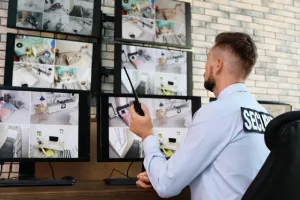Purpose of a Control Room in Emergencies
The Beating Heart of Security
When something goes wrong, all eyes turn to the control room. It is the beating heart of any security operation, the place where information comes together and decisions are made. Think of it like the cockpit of an aircraft. The pilot doesn’t fly by instinct alone, they rely on their instruments. In the same way, a security control room gives operators the tools, intelligence, and authority to guide the response and keep people safe.
Without a control room, incidents become chaotic. With one, you have order, coordination, and direction.

Why Emergencies Test Control Rooms
Emergencies put pressure on everyone. People panic, staff freeze, and events move quickly. The control room is different. It is designed to cut through the noise. Operators use CCTV, access control, and communication systems to see the bigger picture and make rapid, accurate decisions.
Example: During a large protest in Central London, the control room spotted agitators moving towards a building entrance before officers on the ground did. By sending security staff early, they prevented a break-in.
Tip: Always keep scanning, never lock your attention on just one camera. Emergencies rarely start where you expect them.
Real-World Scenarios
During the Manchester Arena bombing (2017), CCTV operators played a crucial role in piecing together the attacker’s movements before the explosion. Their footage supported both the emergency response and later investigations.
On the other hand, there have been incidents where poor communication from control rooms led to delays in evacuation and higher casualty numbers. These examples highlight why SCR operators must always remain alert, accurate, and proactive.
What Makes a Great Control Room Operator
Technology and systems are vital, but what really makes a difference in an emergency is the operator. Great SCR operators share certain qualities that separate them from the rest:
Sharp awareness: They don’t just watch screens, they notice patterns, spot unusual behaviour, and act before a problem escalates.
Calm under pressure: Even when alarms sound and radios are alive with chatter, they keep a level head and focus on solutions.
Quick decision-making: They know hesitation wastes time, so they weigh up the facts fast and take action.
Clear communication: They choose words carefully, knowing that one confident instruction can calm hundreds of people.
Team player mindset: They understand that the control room is the nerve centre, but success depends on supporting officers on the ground and working with emergency services.
Preparedness: They drill, rehearse, and plan ahead so that in a real crisis, their responses are automatic.
Example: During a major power outage in a hospital, the SCR operator stayed calm, coordinated staff movements, and ensured critical areas were prioritised for backup power. Because of their quick, confident actions, patients were safe and chaos was avoided.
Tip: Don’t wait for a crisis to test your ability. Use quieter shifts to practise decision-making scenarios, test communication lines, and challenge yourself to think “what if?”
The Power of Communication
In an emergency, your voice is more powerful than any camera or alarm. The words you choose can either steady the crowd or spark chaos. A single, clear announcement has the power to move hundreds of people safely and calmly. On the other hand, a rushed or confusing message can create panic, block exits, and put lives at risk.
Example: During a fire evacuation at a shopping centre, a calm instruction from the control room, “Please walk to the nearest exit, security staff will guide you,” stopped a rush and prevented injury.
Tip: Practise announcements out loud. If you stumble during training, you will stumble under pressure.
Technology in Action
Control rooms rely on advanced systems, but technology alone cannot manage an incident. It is the operator who interprets the data, makes decisions, and communicates effectively.
| Technology | Emergency Use | Key Risk if Misused |
|---|---|---|
| CCTV | Identifies threats, tracks suspects, and supports evacuation | Missing suspicious behaviour, poor camera positioning |
| Fire/Intruder Alarms | Confirms incident type and location | False alarms leading to a delay in real emergencies |
| Access Control | Secures or opens areas to guide people | Locking escape routes accidentally |
| Radios | Direct staff to priority areas | Confusion if the language is unclear or the channels overlap |
Tip: Know your systems inside out. A system is only as good as the person using it.
Human Element Under Pressure
Technology may support you, but it is the human operator who truly makes the difference. In the middle of an emergency, fear spreads quickly. Staff may hesitate, the public may panic, and even emergency responders look to the control room for direction. Your ability to stay calm is what holds everything together.
Example: In one transport hub incident, the operator’s calm voice over the PA system turned potential chaos into an orderly evacuation. People followed instructions because they trusted the authority of the message.
Tip: Breathe, focus, and remember, your calmness spreads to others.
Key Considerations for SCR Operators
Emergencies move fast, and hesitation costs time: A single delayed decision or unclear instruction can turn a manageable incident into a major crisis.
Communication must be clear, lawful, and professional: Every word matters. Avoid jargon, keep it simple, and always align with compliance standards such as SIA and BSI.
Rehearsals and drills build instinct: Practice is what turns theory into muscle memory. In high-pressure moments, you won’t rise to the occasion, you’ll fall back on your training.
Know your site inside out: Evacuation routes, muster points, emergency contacts, these should be second nature. Familiarity builds confidence and authority when leading others.
Your calmness sets the tone: Staff and the public will mirror your composure. If you project confidence and clarity, others will follow your lead.
Preparedness protects lives: The more you train, the more effectively you can manage panic, protect people, and support emergency services.

